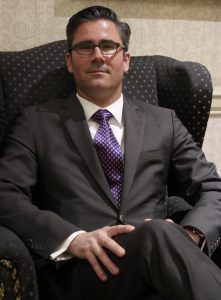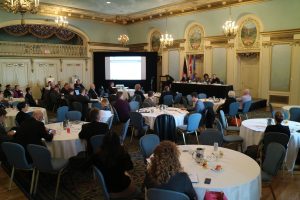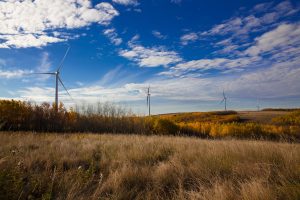By David Dodge & Dylan Thompson

Kipp Horton is the CEO of Wind River Power and he knows how critical financing is to renewable energy projects: “We all know there’s large amounts of environmental benefits associated with renewable energy. The challenge is that all the costs are up front in the form of capital. There’s very low operating and maintenance costs on a long-term basis because, of course, the fuel is free, but the challenge is that it’s tremendously intensive from a capital perspective. So financing, whether you’re talking about equity or debt financing, is very crucial to the viability of a project.” Wind River built the Box Springs wind farm in a public private partnership with the City of Medicine Hat. Photo David Dodge, GreenEnergyFutures.ca
It’s no secret that the Germans have done a lot right when it comes to renewable energy. They have among the highest renewable capacity in the world! So, for a fledgling renewable market like Alberta, the 12th Annual Canadian-German Wind and Solar Energy Conference, held March 23 in Calgary, is a great opportunity to learn from the best.
The theme of this year’s conference was the coming renewable energy boom in Alberta. The challenge for renewable energy projects is not securing the fuel, the sun and wind are free. Rather the challenge is securing financing for projects that have high, upfront capital costs. Installing a solar system on a home takes $20,000 to $30,000. Building a single giant wind turbine costs $2 to $4 million. Building a 300 megawatt wind farm costs $600 million.
Alberta has pledged to replace it’s dirty, coal-fired energy fleet with renewable energy. “By 2030, renewable sources like wind and solar will account for up to 30 per cent of electricity generation.” That’s what Alberta’s Climate Leadership plan says. It also says two-thirds of “Alberta’s generating capacity will be replaced by renewable energy, one-third will be replaced by natural gas.”
You can interpret this a number of different ways, but suffice to say Alberta is calling for the building of somewhere between four and seven gigawatts of renewable energy in the next fifteen years. If we use a big wind project as a proxy, this means Alberta will need between $8 and $14 billion in investment.
So where does the financing come from?
A proven technology

Anticipating a solar and wind boom in Alberta industry representatives at the 12th Annual Canadian German Wind and Solar Energy Conference in Calgary heard about advances in wind energy technology than can help stabilize the grid and comprise as much as 50% of Alberta’s grid. Photo David Dodge, GreenEnergyFutures.ca
We caught up with Tim Poole, managing director at ATB financial at the German wind and solar conference. He explains that uncertainty, as always, is anathema to investors.
“The main thing we look to is a cash flow stream in the future that you can depend on that will pay back the loan,” says Poole. “A lot of that really comes down to the developer finding the right location and then they get a wind assessment that says, ‘At a given location this per cent of the time we should expect this kind of wind.’ Then we can figure out how much debt it can support.”
From a banker’s perspective wind is a proven technology and developers get two years of wind data before breaking ground, so they have a very good idea of what the resource is and how much electricity they can produce. However, just because the resource is there, doesn’t mean the money is as well.
“The Alberta market’s very challenging for power,” says Poole. “Essentially, it’s called a merchant market. You take the price based on a supply and demand for a given hour.”
“The number one challenge, which is the topic of discussion on everyone’s plate these days, is price certainty,” says Kipp Horton, president and CEO of Wind River Power. “In 2015, the price of electricity in Alberta averaged 3.3 cents a kilowatt hour, and in fact the wind energy producers, because of the profile of the production, actually received less than that average, only 2.2 cents per kilowatt hour.”
“For these projects to get done with financing, you really require someone to be buying your power under a contract,” says Poole.
This is why power purchase agreements are so ubiquitous in Ontario and Quebec. Contracts for wind are being signed in the 6 – 8 cents per kWh range today. The contracts provide a consistent return on investment to ease the fears of jittery bankers.
In a word no source of electricity in Alberta is making money at 3.3 cents. Ironically, under Alberta’s current system, dirty, polluting sources of electricity are paid more and clean sources less. So how to get around these problems?
Wind done right
You could do what ATB and Wind River Power did in the case of the Box Springs Wind Farm. It was built as an innovative public-private partnership between Wind River and the City of Medicine Hat (aka “The Gas City”).
The city wanted to diversify into clean energy so they simply offered Wind River Power a long term contract to buy wind power which in turn allowed the company to borrow money to build a small $12 million, 6-megawatt wind farm right in the city limits of Medicine Hat.
“It actually makes it the largest wind farm in Canada located in a municipal boundary,” says Kipp Horton. This deal gave two key ingredients to bankers: price certainty for the electricity produced and Medicine Hat’s AAA credit rating.
ATB was involved in that project and another similar project: “A second project we did is called Bull Creek. It was a consortium of school boards buying the power … it gave some certainty to the school boards and their budgets,” says Poole.
Alberta-based BluEarth Renewables signed up the school boards and then built a 29.2 megawatt wind farm near provost, Alberta.
Renewable Energy Credit

BluEarth Renewables of Calgary worked with a consortium of Alberta School boards to enter into a long term contract to provide renewable energy at a predictable price for Alberta Schools. The contract enabled BluEarth to get financing to build the 29.2 megawatt wind project near Provost, Alberta. Photo BluEarth Renewables
Alberta is launching a carbon tax and is hinting about using Renewable Energy Credits (RECs) to help level the playing field for clean energy in Alberta. The idea is to provide a credit of 3.5 cents per kilowatt hour for producers of clean energy.
However, Poole says this falls short of what’s needed.
“The challenge is, as a lender, that’s not enough,” says Poole. “We still look for certainty for the rest of it because the… It cost more than that for that power. So, that’s a subsidy that helps bring it up, and it could result in some of it being done on balance sheets as I referred to, but it’s still tough to finance it without certainty for what they’ll get for the remainder of the power.”
Dan Balaban is the president and CEO of Greengate Power. His company developed 450 MW of wind projects in Alberta by securing RECs from California. He says this approach will not attract the investment needed to build significant renewable energy in Alberta.
He is advocating for something called contracts for differences (CFD). Instead of paying 3.5 cents per kilowatt hour for RECS he says Alberta should offer CFDs that bundle the RECs with power at a price.
“The contract would have a price of, for example 6.3 cent per kilowatt hour,” says Balaban. “A project would continue to sell into the Alberta pool. If the price the producer receives is lower it would be trued up to 6.3 cents and if it’s higher the producer would owe the government the difference.”
“The government would get a good competitive prices for renewable energy, the banker would buy in and I think we would see the lowest prices ever paid for renewables,” says Balaban.
We have the best wind resource in Canada and this could make Alberta the best place in the world to invest in renewable energy.


